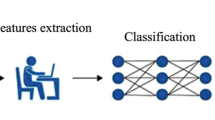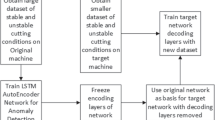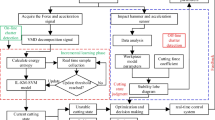Abstract
Chatter is a kind of self-excited vibration which frequently occurs in high-speed milling processes, which induces severe damage to both spindle tools and workpieces. In this paper, we introduce a new chatter detection technique using ordered-neurons long short-term memory (ON-LSTM) and population based training (PBT). First, we conduct a large number of milling experiments on a computer numerical control (CNC) milling machine with 4 accelerometers to get the dataset and employ vanilla LSTM for chatter detection. Then, to interpret the performance on time series of recurrent neural networks (RNN), a variation of LSTM named ON-LSTM is applied to chatter detection and a hyperparameter tuning method PBT is used for training. Finally, we compare the trained ON-LSTM with the time-frequency spectrum of the original signals obtained by short-time Fourier transform (STFT), and they show a certain degree of consistency.



















Similar content being viewed by others
References
Quintana G, Ciurana J (2011) Chatter in machining processes: a review. Int J Mach Tools Manuf 51(5):363–376. Elsevier
Cao H, Zhang X, Chen X (2017) The concept and progress of intelligent spindles: a review. Int J Mach Tools Manuf 112:21–52. Elsevier
Ding Y, Zhu L, Zhang X, Ding H (2010) A full-discretization method for prediction of milling stability. Int J Mach Tools Manuf 50(5):502–509. Elsevier
Zhang Z, Li H, Meng G, Tu X, Cheng C (2016) Chatter detection in milling process based on the energy entropy of VMD and WPD. Int J Mach Tools Manuf 108:106–112. Elsevier
Shi F, Cao H, Zhang X, Chen X (2019) A chatter mitigation technique in milling based on H\(\infty \)-ADDPMS and piezoelectric stack actuators. Int J Adv Manuf Technol 101(9–12):2233–2248. Springer
Xi S, Cao H, Zhang X, Chen X (2019) Zoom synchrosqueezing transform-based chatter identification in the milling process. Int J Adv Manuf Technol 101(5–8):1197–1213. Springer
Wan M, Liang XY, Yang Y, Zhang WH (2020) Suppressing vibrations in milling-trimming process of the plate-like workpiece by optimizing the location of vibration absorber. J Mater Process Technol 278:116499. Elsevier
Cao H, Yue Y, Chen X, Zhang X (2018) Chatter detection based on synchrosqueezing transform and statistical indicators in milling process. Int J Adv Manuf Technol 95(1–4):961–972. Springer
Altintas Y, Chan PK (1992) In-process detection and suppression of chatter in milling. Int J Mach Tools Manuf 32(3):329–347. Elsevier
Cao H, Yue Y, Chen X, Zhang X (2017) Chatter detection in milling process based on synchrosqueezing transform of sound signals. Int J Adv Manuf Technol 89(9–12):2747–2755. Springer
Sun Y, Zhuang C, Xiong Z (2015) A scale factor-based interpolated DFT for chatter frequency estimation. IEEE Trans Instrum Meas 64(10):2666–2678. IEEE
Tansel I, Wang X, Chen P, Yenilmez A, Ozcelik B (2006) Transformations in machining. Part 2. Evaluation of machining quality and detection of chatter in turning by using s-transformation. Int J Mach Tools Manuf 46(1):43–50. Elsevier
Ma L, Melkote SN, Castle JB (2013) A model-based computationally efficient method for on-line detection of chatter in milling J Manuf Sci Eng 135(3). American Society of Mechanical Engineers Digital Collection
Hynynen KM, Ratava J, Lindh T, Rikkonen M, Ryynänen V, Lohtander M, Varis J (2014) Chatter detection in turning processes using coherence of acceleration and audio signals. J Manuf Sci Eng 136(4). American Society of Mechanical Engineers Digital Collection
Cao H, Zhou K, Chen X (2015) Chatter identification in end milling process based on EEMD and nonlinear dimensionless indicators. Int J Mach Tools Manuf 92:52–59. Elsevier
Nair U, Krishna BM, Namboothiri VNN, Nampoori VPN (2010) Permutation entropy based real-time chatter detection using audio signal in turning process. Int J Adv Manuf Technol 46(1–4):61–68
Gradišek J, Baus A, Govekar E, Klocke F, Grabec I (2003) Automatic chatter detection in grinding. Int J Mach Tools Manuf 43(14):1397–1403. Elsevier
Pérez-Canales D, Álvarez-Ramírez J, Jáuregui-Correa JC, Vela-Martínez L, Herrera-Ruiz G (2011) Identification of dynamic instabilities in machining process using the approximate entropy method. Int J Mach Tools Manuf 51(6):556–564. Elsevier
Kuljanic E, Totis G, Sortino M (2009) Development of an intelligent multisensor chatter detection system in milling. Mech Syst Signal Process 23(5):1704–1718. Elsevier
Cao H, Zhou K, Chen X, Zhang X (2017) Early chatter detection in end milling based on multi-feature fusion and 3σ criterion. Int J Adv Manuf Technol 92(9–12):4387–4397. Springer
Devillez A, Dudzinski D (2007) Tool vibration detection with eddy current sensors in machining process and computation of stability lobes using fuzzy classifiers. Mechanical Systems and Signal Processing 21 (1):441–456. Elsevier
Hochreiter S, Schmidhuber J (1997) Long short-term memory. Neural Computation 9 (8):1735–1780. MIT Press
Graves A, Schmidhuber J (2005) Framewise phoneme classification with bidirectional LSTM and other neural network architectures. Neural Networks 18(5–6):602–610. Elsevier
Greff K, Srivastava RK, Koutník J, Steunebrink BR, Schmidhuber J (2016) LSTM: a search space odyssey. IEEE Transactions on Neural Networks and Learning Systems 28(10):2222–2232. IEEE
Doetsch P, Kozielski M, Ney H (2014) Fast and robust training of recurrent neural networks for offline handwriting recognition. In: 2014 14th international conference on frontiers in handwriting recognition. IEEE, pp 279–284
Graves A (2013) Generating sequences with recurrent neural networks. arXiv:1308.0850
Zaremba W, Sutskever I, Vinyals O (2014) Recurrent neural network regularization. arXiv:1409.2329
Luong MT, Sutskever I, Le QV, Vinyals O, Zaremba W (2014) Addressing the rare word problem in neural machine translation. arXiv:1410.8206
Fan Y, Qian Y, Xie FL, Soong FK (2014) TTS synthesis with bidirectional LSTM based recurrent neural networks. In: Fifteenth annual conference of the international speech communication association
Shen Y, Tan S, Sordoni A, Courville A (2018) Ordered neurons: Integrating tree structures into recurrent neural networks. arXiv:1810.09536
Jaderberg M, Dalibard V, Osindero S, Czarnecki WM, Donahue J, Razavi A, Vinyals O, Green T, Dunning I, Simonyan K, et al. (2017) Population based training of neural networks. arXiv:1711.09846
Patel B, Mann B, Young K (2008) Uncharted islands of chatter instability in milling. Int J Mach Tools Manuf 48(1):124–134. Elsevier
Funding
This work is supported by the National Science Foundation of China (51575423,11772244) and China Scholarship Council (201906280415).
Author information
Authors and Affiliations
Corresponding author
Additional information
Publisher’s note
Springer Nature remains neutral with regard to jurisdictional claims in published maps and institutional affiliations.
Rights and permissions
About this article
Cite this article
Shi, F., Cao, H., Wang, Y. et al. Chatter detection in high-speed milling processes based on ON-LSTM and PBT. Int J Adv Manuf Technol 111, 3361–3378 (2020). https://doi.org/10.1007/s00170-020-06292-9
Received:
Accepted:
Published:
Issue Date:
DOI: https://doi.org/10.1007/s00170-020-06292-9




